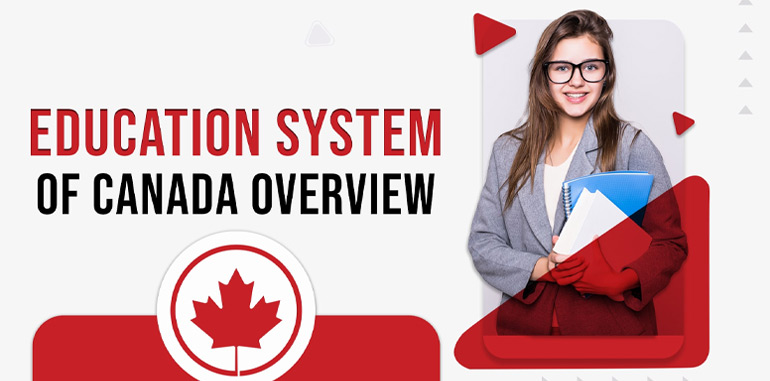University
Canadian Study System
- Home
- Study Visa
- Canadian Study System

Canadian Study System
When it comes to accessible and high-quality education for international students, Canada is among the top countries in the world. However, before you can determine which program is the best fit for you, it's important to understand the levels of study available in Canada.
Elementary & Secondary Education
In Canada, it is required by law for children to attend school from the age of five or six until they reach 16 or 18, depending on the province or territory. The education system consists of kindergarten (elementary school) and grades 1 to 12. Upon completing Grade 12, students are awarded a high school diploma that enables them to pursue post-secondary education at colleges and universities. In order for foreign nationals to attend college or university in Canada, they must show proof of having a high school diploma.
Canada has both private and public schools. Private schools offer specialized curriculums and resources but require tuition fees. Public schools, on the other hand, are entirely funded by the Canadian government and teach government-mandated curriculums.
Cost of high school in Canada
In Canada, residents are not charged for attending public high school or secondary school. However, international students may be subject to fees that range from about $8,000 CAD to $14,000 CAD per year. To confirm the cost, if any, for international students at the school you are considering for your teenager, it is advisable to check with the school directly.
Post-Secondary Education
Once you have obtained your high school diploma, any educational program that you undertake is considered post-secondary education. There are various types of post-secondary schools, each with a unique purpose, as outlined below:
-
-
College
-
Trade School/Apprenticeships
-
Vocational School
Governments play a crucial role in ensuring that the schools and the programs they offer meet certain standards and are recognized as legitimate institutions to grant degrees, diplomas, certificates, and other qualifications. This helps to ensure that students receive a high-quality education and that their credentials are recognized in the job market and beyond.
University
Universities are institutions of higher education that provide post-secondary education and have the authority to award various degrees in a wide range of disciplines and subjects. Some of the degree options that universities offer include Bachelor's, Master's, and Doctorate degrees, as well as Associate degrees and certificate programs.
-
Bachelor’s Degree: A basic degree that takes three to four years to complete.
-
Master’s Degree: A more advanced degree that usually takes one to three more years of study.
-
Doctoral degree: The most advanced degree offered by Canadian universities that requires three or more years of study and research following a master’s degree.
College
A college is an institution of higher education that provides certificate and/or diploma programs, although it cannot grant degrees. However, certain accredited colleges may offer bachelor's or master's degree programs. Typically, college programs focus more on career development than those of universities. They frequently provide courses that enhance a person's skills and job prospects, like language training, as well as training programs or apprenticeships in skilled trades such as carpentry or welding.
Trade School/Apprenticeships
A skilled trade is a type of job that involves specialized work, often involving physical labor and hands-on training. Unlike many professions that require a bachelor's degree, skilled trades typically do not require such formal education. Instead, individuals who are interested in pursuing a career in a skilled trade often attend trade schools, which are often smaller programs within colleges or vocational schools. After completing their training, aspiring tradespeople may choose to undertake an apprenticeship, where they work closely with a more experienced tradesperson to further develop their skills in the trade.
Vocational School
It's worth noting that vocational schools offer educational programs at both the secondary and post-secondary levels. Unlike traditional schools, a high school diploma isn't always a requirement to enroll in vocational school. These programs focus on teaching students the technical skills required for specific jobs, which can vary from skilled to low-skilled occupations. Ultimately, vocational programs prepare students to enter the workforce with the necessary skills to succeed.
Levels of Education in Quebec
In Canada, elementary and secondary education typically consists of a twelve-grade system, except in Quebec. Students who complete Grade Twelve graduate from secondary school and receive a high school diploma, making them eligible for post-secondary studies. However, Quebec's education system operates slightly differently from the rest of Canada.
In contrast to other Canadian provinces, Quebec's elementary and secondary school system comprises only eleven grades. Upon completing Grade Eleven, individuals receive a secondary school certificate. However, Quebec has an additional level of education between secondary school and undergraduate university programs known as CEGEP (Collège d’enseignement général et professionnel). CEGEPs are educational institutions that permit students to select a specialized program which leads to a Diplôme d’études collégiales (DEC). Students in Quebec are only eligible to begin an undergraduate university program after completing a CEGEP program. In the CEGEP system there are two types of programs:
Levels of Post-Secondary studies
Canadian universities, colleges, and vocational school use the same terms to describe common educational pathways and credentials. The length and composition of the educational programs effect on eligibility for employment and immigration opportunities in Canada for international students.
| Undergraduate Studies |
|
|---|---|
| Graduate Studies |
|
University Transfer Program
Canadian colleges and technical institutes offer University Transfer programs in collaboration with universities. The institutions have partnerships and agreements that determine which college programs are eligible for transfer to a degree program, which universities students can transfer to, and which courses will be applicable for the degree. The University Transfer program allows students to complete the first two years of a four-year university degree at a college, providing them the convenience of transferring to a university to finish the final two years of the degree.


